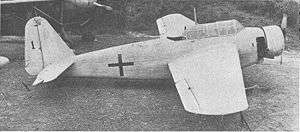Kyushu K11W
The Kyūshū K11W Shiragiku (白菊, "White Chrysanthemum") made by the Kyūshū Aircraft Company, was a land-based bombing trainer aircraft which served in the Imperial Japanese Navy Air Service in the latter years of World War II. As indicated by its Japanese designation, "training aircraft for on-board work" (機上作業練習機, kijō sagyō renshū-ki?), it was designed to train crews in operating equipment for bombing, navigation, and communication, as well as navigation techniques. A total of 798 K11Ws were manufactured, including a small number of K11W2 ASW and transport aircraft alongside the K11W1 trainer variant. These aircraft were also used in kamikaze mission during the last stages of the Pacific War.
| K11W Shiragiku | |
|---|---|
 | |
| Kyūshū K11W in 1945 surrender markings (painted white and with green crosses in the place of the red Hinomarus). | |
| Role | Bomber crew trainer (K11W1) |
| Manufacturer | Kyūshū Aircraft Company |
| First flight | 1942 |
| Introduction | 1943 |
| Primary user | Japan |
| Produced | 1942-1945 |
| Number built | 798 |
Design and development

The Kyūshū K11W had a rather simple mid-wing layout. The crew consisted of a pilot and gunner/radio operator sitting in line under the canopy and the trainee bombardier, trainee navigator, and instructor in the lower fuselage beneath the wing.
The K11W served as the basis for the Q3W1 Nankai (南海, "South Sea") anti-submarine patrol aircraft, which did not progress beyond the development phase. It was enlarged, but unlike the K11W, had retracting landing gear.
Variants

- K11W1 : The basic bomber crew trainer, of all-metal construction with fabric-covered control surfaces.
- K11W2 : Anti-submarine warfare and transport version of all-wood construction.
- Q3W1 Nankai : Dedicated Anti-submarine warfare aircraft based on the K11W. 1 built.
Specifications (K11W1)
Data from Japanese Aircraft of the Pacific War[1]
General characteristics
- Crew: 5
- Length: 10.24 m (33 ft 7 in)
- Wingspan: 14.98 m (49 ft 2 in)
- Height: 3.93 m (12 ft 11 in)
- Wing area: 30.5 m2 (328 sq ft)
- Empty weight: 1,677 kg (3,697 lb)
- Gross weight: 2,640 kg (5,820 lb)
- Powerplant: 1 × Hitachi GK2B Amakaze 21 9-cylinder air-cooled radial piston engine, 384 kW (515 hp)
Performance
- Maximum speed: 230 km/h (140 mph, 120 kn) at 1,700 m (5,577 ft)
- Cruise speed: 175 km/h (109 mph, 94 kn) at 1,000 m (3,281 ft)
- Range: 1,760 km (1,090 mi, 950 nmi)
- Service ceiling: 5,620 m (18,440 ft)
- Time to altitude: 3,000 m (9,843 ft) in 19 minutes 35 seconds
Armament
- Guns: 1 × 7.7 mm rear-firing machine gun
- Bombs: 2 × 30 kg (66 lb) bombs on training role, or 1 × 250 kg (550 lb) bomb on kamikaze missions
References
- Notes
- Francillon 1979, p. 332.
- Bibliography
- Francillon, Ph.D., René J. Japanese Aircraft of the Pacific War. London: Putnam & Company Ltd., 1970 (2nd edition 1979). ISBN 0-370-30251-6.
- Mondey, David. The Concise Guide to Axis Aircraft of World War II. London: Chancellor Press, 1996. ISBN 1-85152-966-7.
External links
| Wikimedia Commons has media related to Kyushu K11W. |